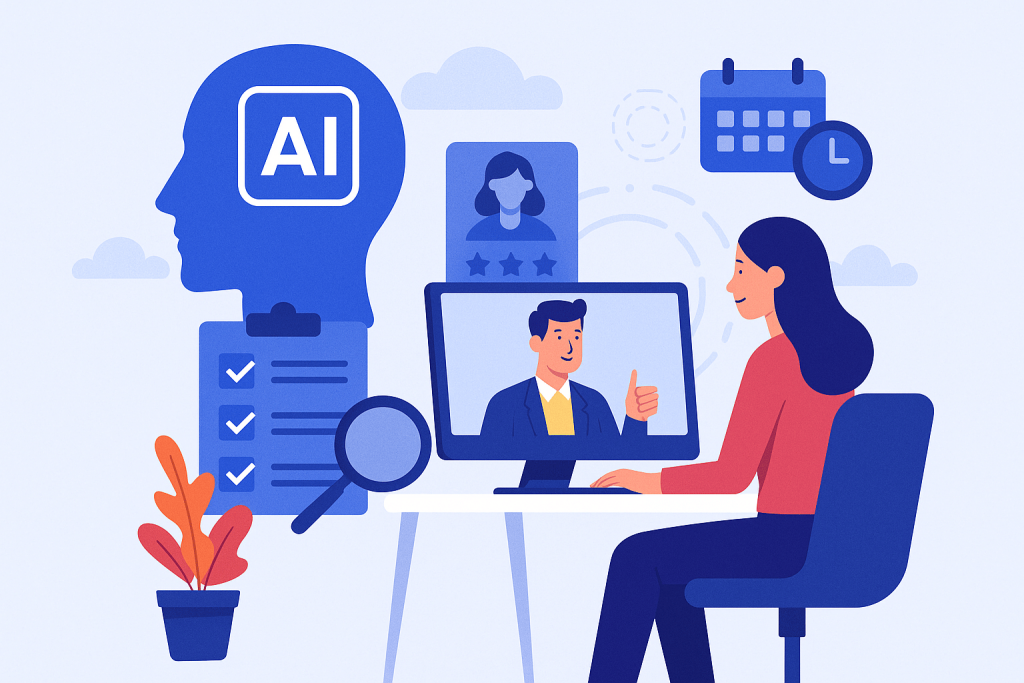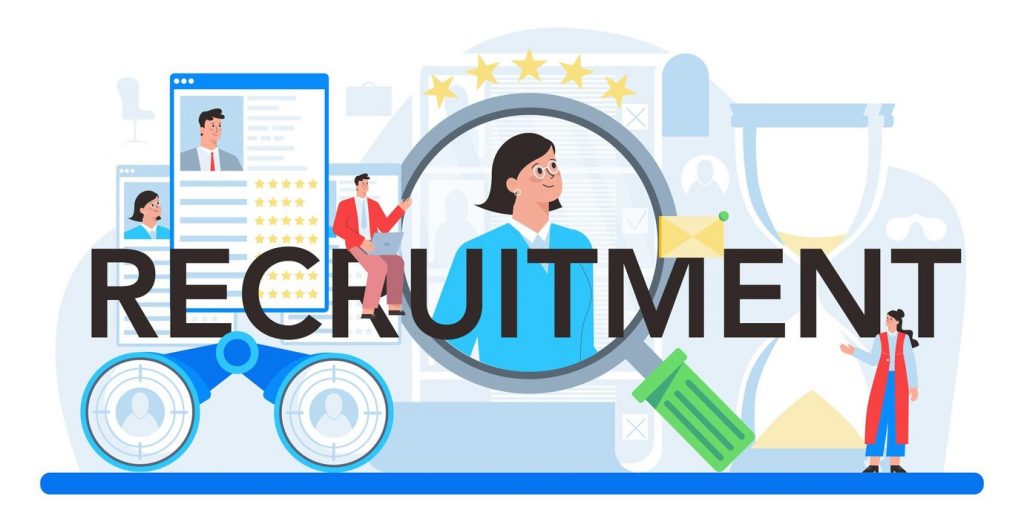TL;DR
What They Are: Digital interview platforms automate and manage the interview process, using AI for scheduling, conducting, and assessing interviews.
Benefits: Save time, reduce bias, and improve scalability, candidate experience, and hiring insights.
Types: Pre-recorded video, live virtual interviews, AI-assisted assessments, and automated scheduling.
Real-Time Insights: Access valuable data on candidate performance and engagement.
Challenges: Technical issues, AI bias, and lack of personal interaction.
Choosing a Platform: Look for ease of integration, customization, cost efficiency, and good candidate experience.
Introduction: The Changing Landscape of Interviews
In the world of talent acquisition, recruitment efficiency and hiring accuracy are no longer a luxury – they’re a necessity for attracting the best talent. The latest innovation to transform this landscape is the rise of AI interview platforms. These cutting-edge recruitment AI tools mark a significant shift from the traditional phone screen, leveraging artificial intelligence to streamline candidate assessment and deliver superior results.
Traditionally, the phone interview was the initial filter to check if a resume truly matched a role. While an effective first step, these phone screens are notoriously time-consuming for recruiters and hiring managers, leading to bottlenecks in the hiring pipeline. AI-powered interview platforms offer a powerful alternative, automating key parts of the process to save valuable time and resources.
In this article, we’ll break down everything you need to know about AI interview platforms and why they may be a game-changer for your hiring process.
What Are AI Interview Platforms?
Digital interview platforms are software solutions designed to facilitate remote hiring by automating and managing different aspects of the recruitment process, including scheduling, conducting, and assessing interviews. These platforms can be AI-powered or rely on pre-recorded video interviews where candidates answer a set of pre-determined questions.
Key Features of AI Interview Platforms:
Pre-recorded Interviews: Candidates answer interview questions at their convenience via video or text-based responses.
Live Virtual Interviews: Some platforms offer live video interview capabilities with AI assistance.
AI-Assisted Screening: AI algorithms analyze answers, body language, and tone to provide insights and rank candidates based on predefined criteria.
Automated Scheduling: AI-driven systems help schedule interviews based on both the interviewer’s and candidate’s availability, reducing administrative workload.
Candidate Analytics: Insights on a candidate’s responses, engagement level, and other metrics that can be used for decision-making.
These platforms are not just for screening, but also help provide deeper insights into candidates’ personalities, skills, and overall fit with the company culture.
Benefits of Using AI Interview Software
Here’s why HR pros are making the switch to AI interview platforms:
Time Efficiency
Digital interviews, especially pre-recorded ones, enable HR teams to review candidates at their convenience without having to schedule numerous phone calls. The scheduling flexibility reduces the back-and-forth and eliminates the time wasted on missed calls or overlapping schedules.
Scalability
As companies grow, scaling the hiring process can become a bottleneck. Digital platforms allow you to handle a high volume of applicants without compromising the quality of the interview process.
Bias Reduction
AI-powered AI interview platforms can help reduce unconscious bias in the recruitment process by providing a standardized way to evaluate candidates. Automated systems grade candidates based on predetermined criteria, which eliminates bias related to voice, accent, appearance, or other non-performance factors.
Enhanced Candidate Experience
Candidates can participate in interviews at a time that suits them, making the process more flexible. Pre-recorded interviews also give them the ability to rehearse their answers and present themselves in the best possible way.
Real-Time Insights
Digital platforms can provide real-time analytics on candidate performance, offering immediate insights into the strengths and weaknesses of each applicant. This data helps recruiters make more informed hiring decisions.
Types of AI Interview Platforms
Digital interview platforms come in various formats, each designed to cater to different needs. Here’s a breakdown of the most common types:
Pre-Recorded Video Interviews
Candidates respond to a set of pre-defined questions on video at their own pace. These interviews are typically asynchronous, meaning there’s no live interaction with the interviewer. HR professionals can watch the responses at their convenience and assess candidates accordingly.
Live Virtual Interviews
Similar to traditional phone or video interviews but with added AI features. These interviews are live, with a real-time video feed, and can incorporate AI tools to assess the candidate’s responses, facial expressions, and tone.
AI-Powered Assessments
Some platforms use AI to evaluate a candidate’s responses during both live and pre-recorded interviews. This can include analyzing facial expressions, body language, and even voice intonation to determine emotional intelligence, confidence, and authenticity.
Automated Scheduling Platforms
These platforms integrate with HR software, allowing candidates to pick interview times based on interviewer availability. Automated scheduling saves HR professionals from the repetitive task of coordinating interviews manually.
Real-Time Insights from AI Interview Platforms
With AI interview platforms, HR professionals gain access to a wealth of data. Here are a few examples of real-time insights that can drive better hiring decisions:
|
Insight |
What it Measures |
Benefits |
|
Sentiment Analysis |
Analyzing the tone and emotional cues of the candidate’s responses. |
Helps gauge a candidate’s attitude and emotional intelligence. |
|
Engagement Metrics |
Tracks how long a candidate spends on each question or section. |
Indicates how invested the candidate is in the interview process. |
|
Word Choice & Linguistics |
Look at the complexity and clarity of the language used. |
Can highlight whether the candidate can communicate clearly and concisely. |
|
Facial Expression Analysis |
Analyzes facial expressions for emotional cues. |
Gives insight into the candidate’s response to certain questions, showing authenticity or discomfort. |
These insights can provide HR professionals with an additional layer of data to evaluate candidates more comprehensively than with a traditional phone interview.
How to Choose the Right AI Interview Platform
When choosing an AI interview platform, it’s important to consider several factors to ensure it aligns with your company’s needs. Here are some key things to look for:
1. Ease of Integration
Make sure the platform can seamlessly integrate with your existing HR software, such as Applicant Tracking Systems (ATS), to avoid manual data entry and ensure a smooth workflow.
2. Customization Options
Look for a platform that allows customization of questions, evaluation criteria, and workflows to match your specific hiring processes.
3. Candidate Experience
Opt for a platform that is easy for candidates to use. A platform with a user-friendly interface ensures that candidates are not discouraged from completing the interview.
4. Analytics and Reporting
The best platforms offer real-time analytics and the ability to track key hiring metrics. Look for features that allow you to measure candidate performance, interview effectiveness, and more.
5. Cost Efficiency
Ensure that the platform provides good value for its price. The features you need should align with the platform’s pricing structure. Some platforms offer scalable pricing based on the number of interviews, while others have subscription models.
Potential Challenges with AI Interview Platforms
While AI interview platforms offer numerous benefits, they come with some challenges that HR professionals should be aware of:
1. Technical Issues
Technical glitches, such as poor internet connections or software incompatibility, can disrupt the interview process. Make sure candidates have the necessary technical support to avoid frustration.
2. AI Bias
Despite efforts to reduce bias, AI algorithms are not foolproof. They can still carry biases based on the data they are trained on. It’s important to audit AI systems regularly to ensure they are fair and objective.
3. Lack of Personal Interaction
Some candidates may feel that digital interviews lack the personal touch that comes with live, in-person interviews. It’s essential to balance digital interviews with human interaction when possible to ensure a positive candidate experience.
Conclusion
The shift from traditional phone screens to AI interview platforms represents a major leap forward for HR professionals. By embracing these tools, companies can streamline their hiring processes, reduce biases, and enhance both candidate and recruiter experiences.
However, it’s crucial to carefully evaluate platforms based on your specific needs and understand the potential challenges, particularly with AI-driven decision-making. The future of recruitment is undoubtedly digital, but HR professionals must remain vigilant in ensuring that technology enhances, rather than diminishes, the human aspect of hiring.
9. FAQ:
Q1: What is an AI interview platform?
An AI interview platform is a software tool designed to facilitate remote hiring processes, such as scheduling, conducting, and assessing interviews. It can be powered by AI to analyze candidate responses and provide insights.
Q2: What are the benefits of using an AI interview platform?
The benefits include time efficiency, scalability, bias reduction, enhanced candidate experience, and real-time insights into candidate performance.
Q3: How do AI interview platforms reduce bias in hiring?
AI-driven platforms can standardize candidate assessments, reducing the impact of human biases related to voice, accent, appearance, or other non-performance factors.



